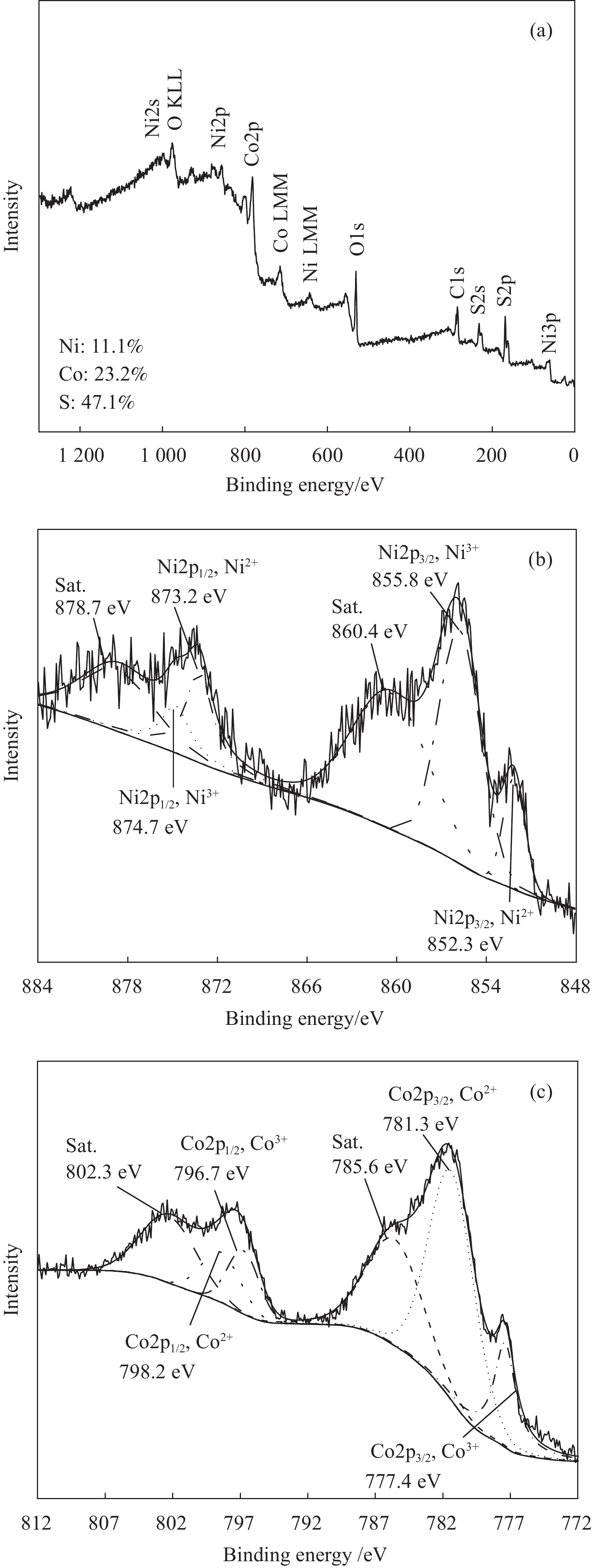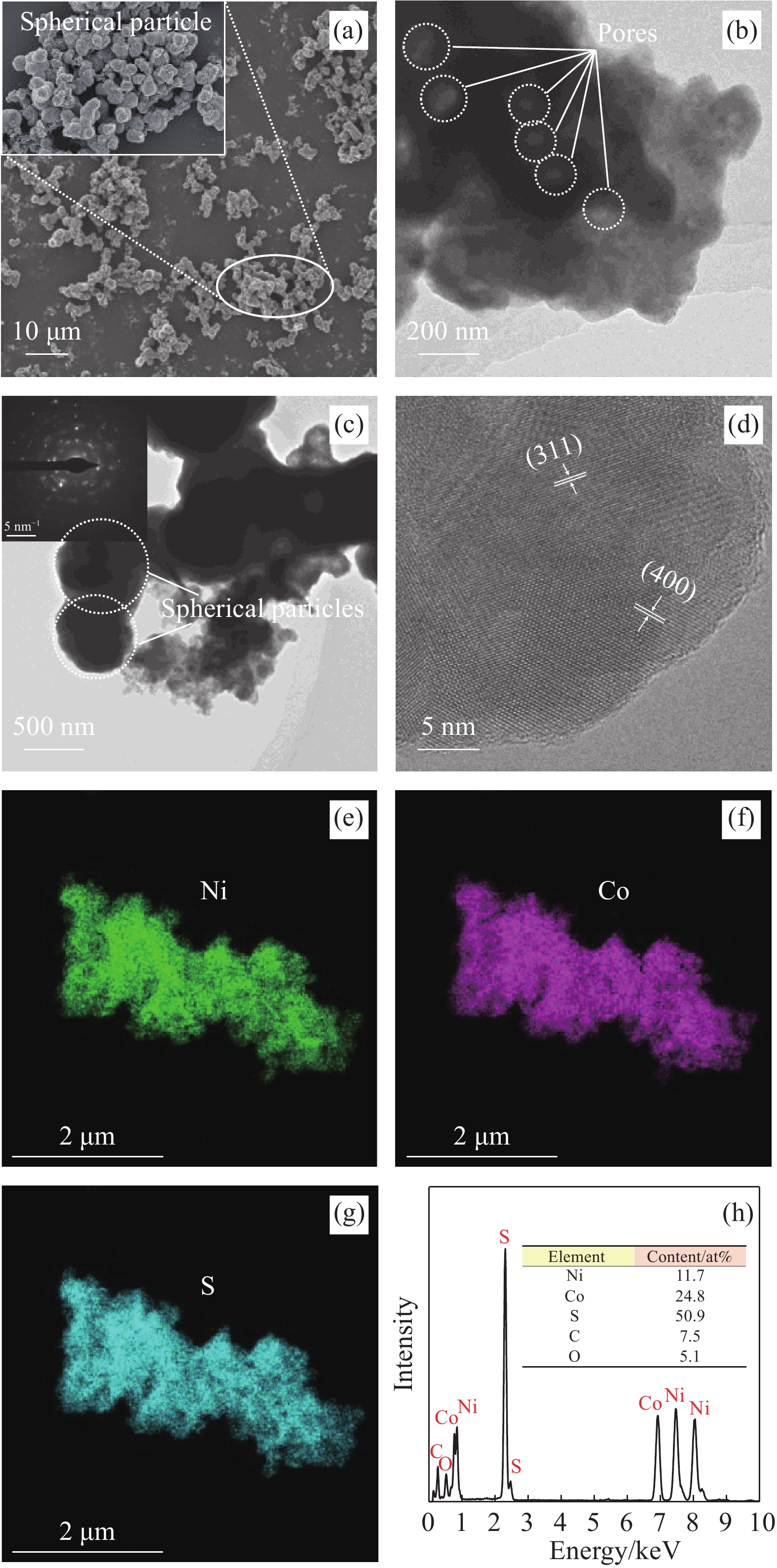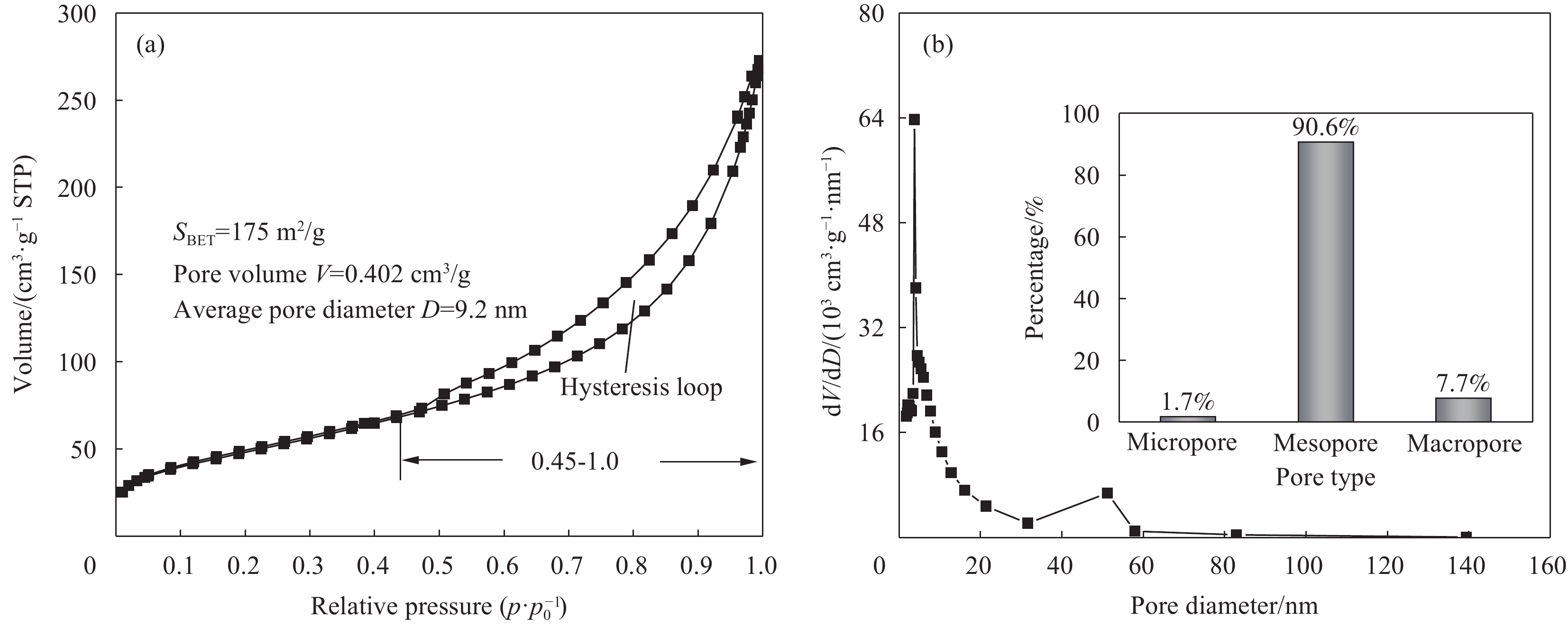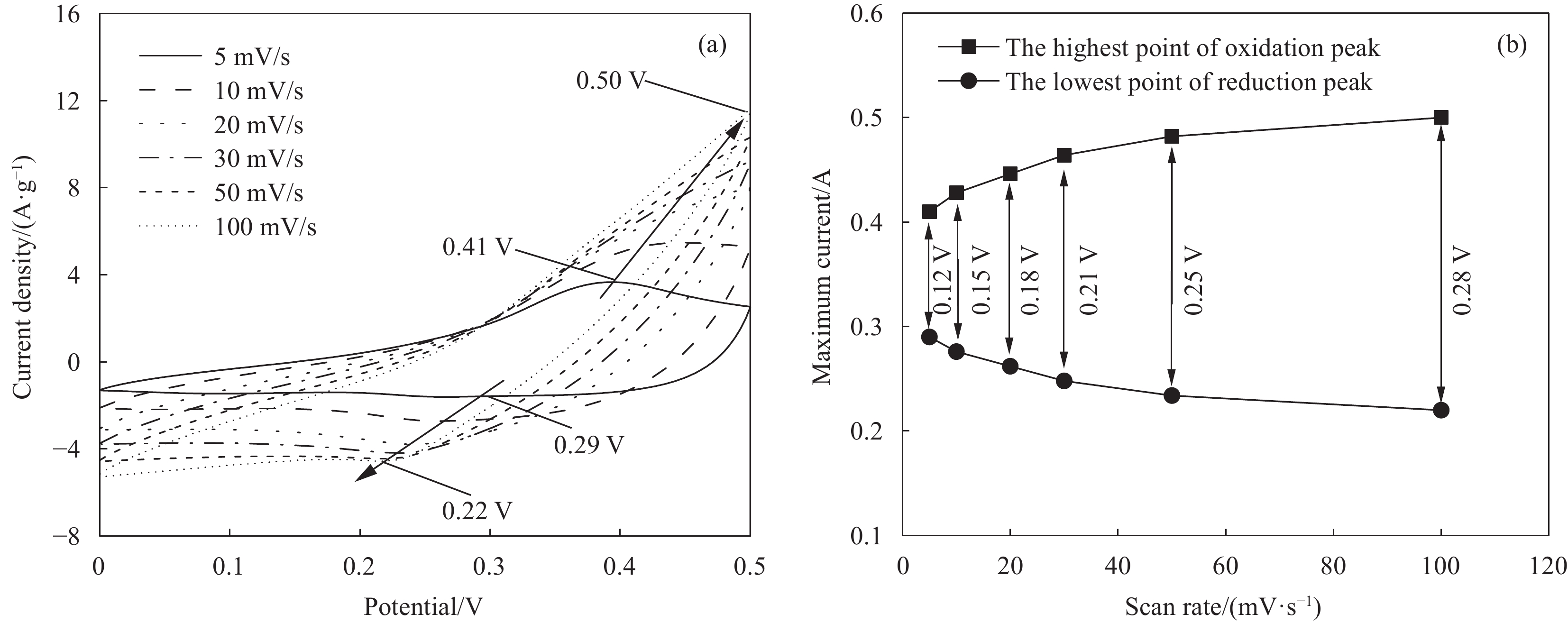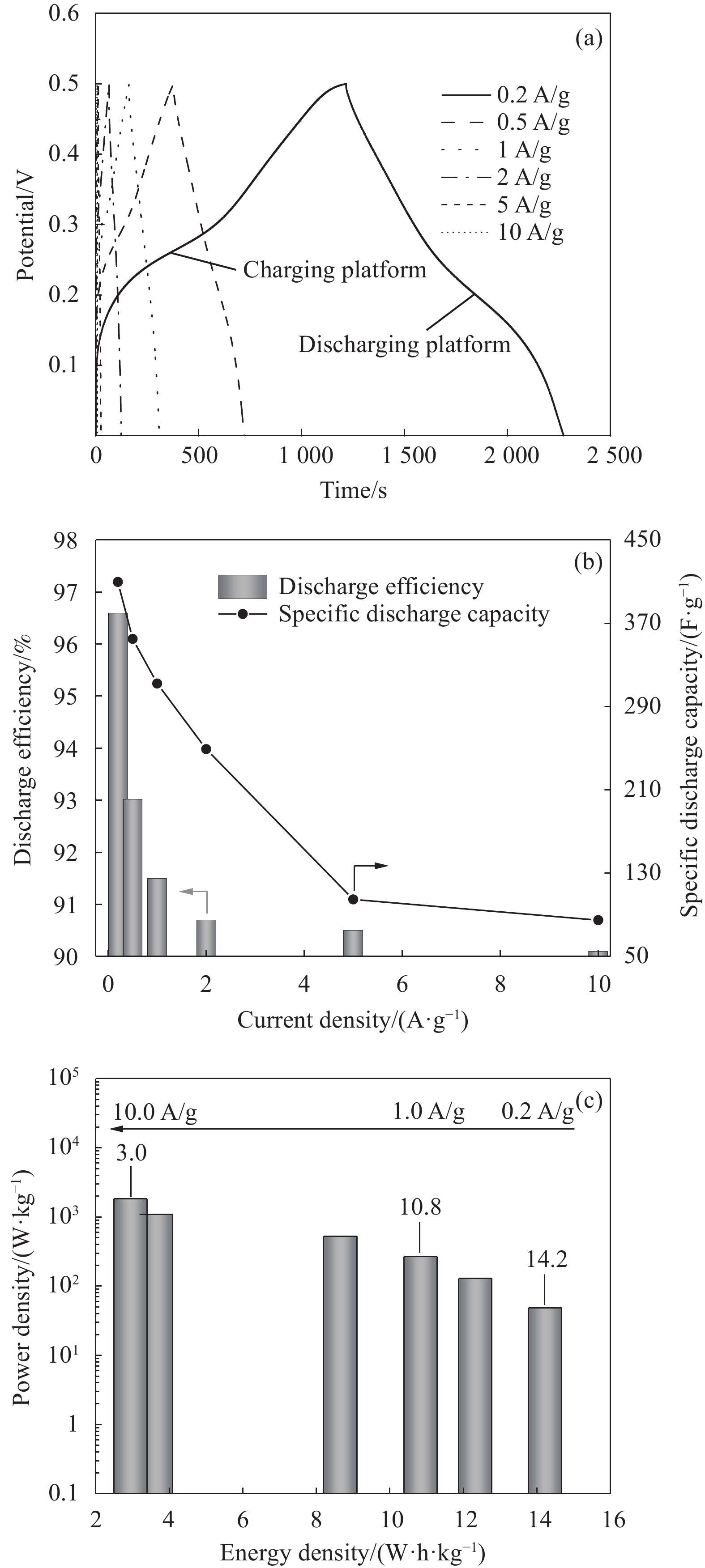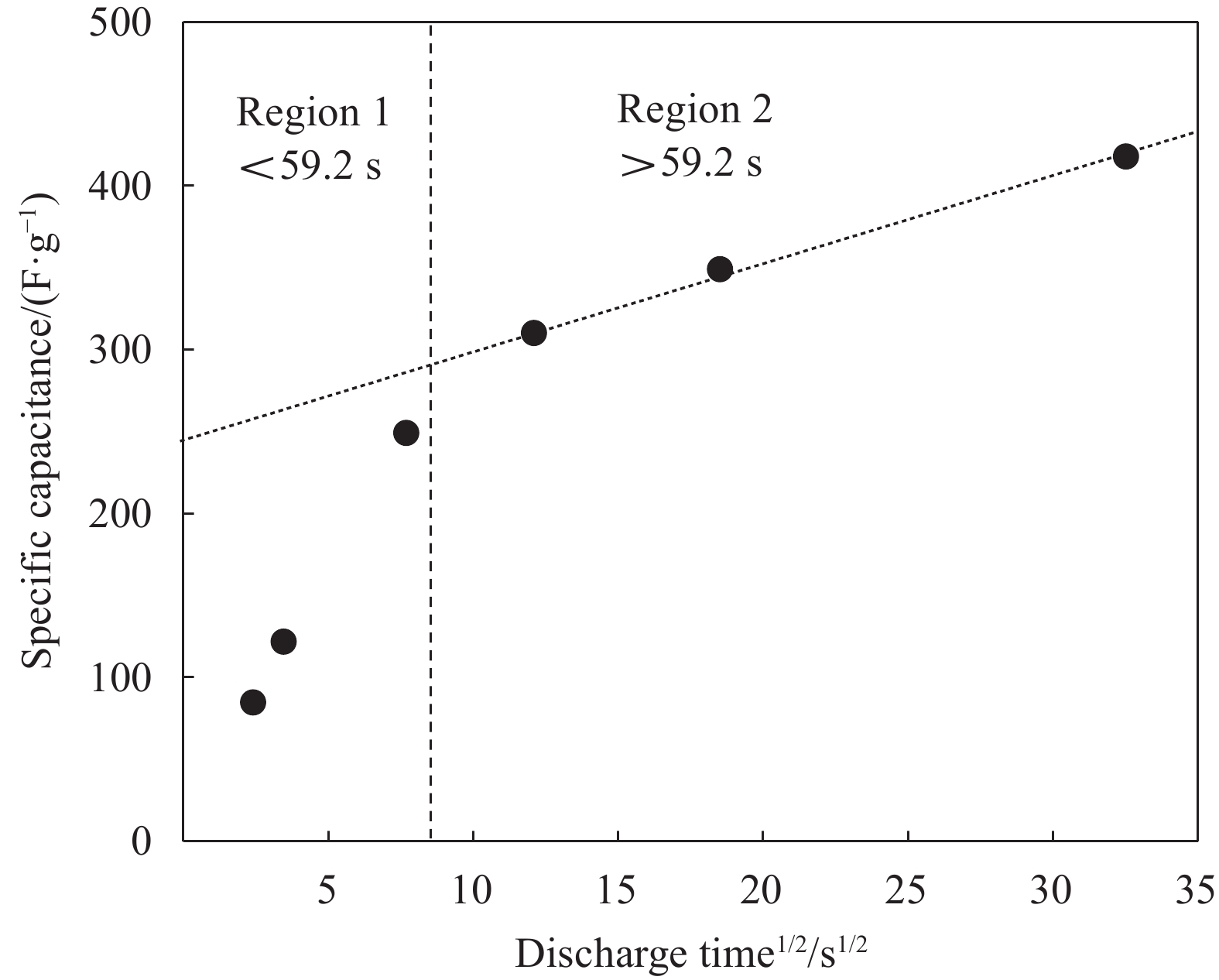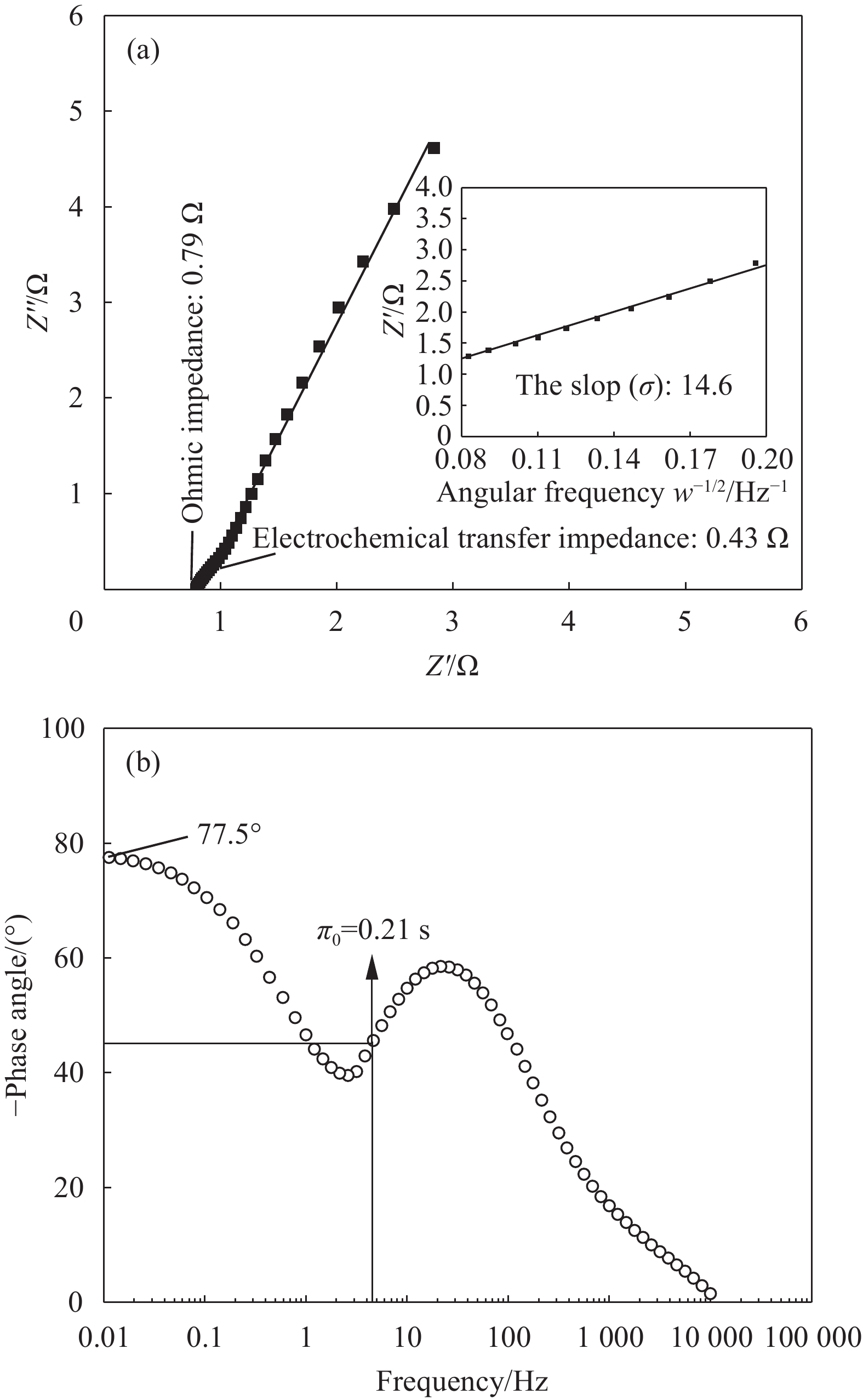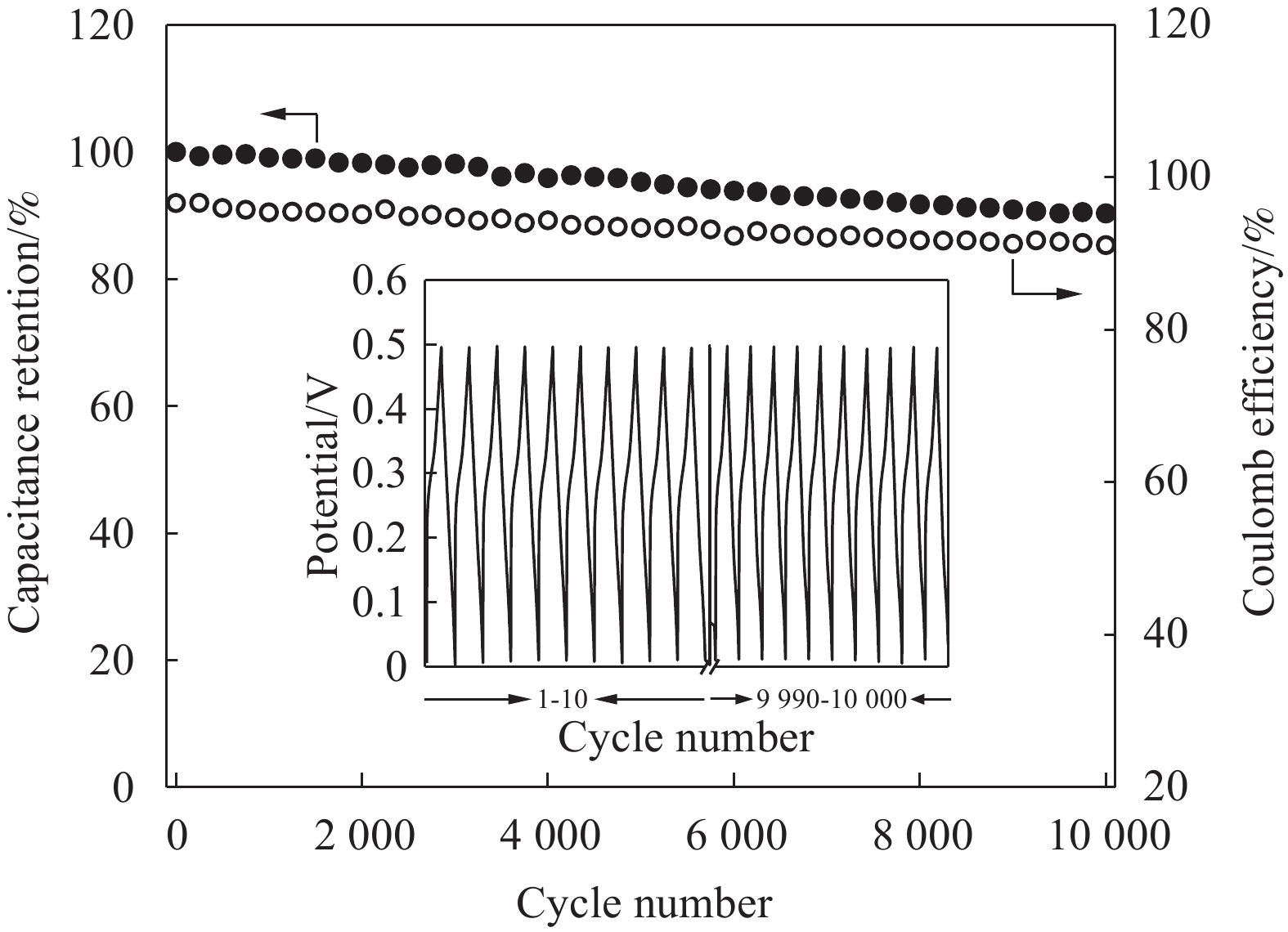Preparation of spherical NiCo2S4 and the electrochemical behavior in KOH solution
-
摘要:
NiCo2S4中Ni和Co元素可以同时参与充放电过程,获得较高的放电比容量和能量密度。对NiCo2S4中双电层电容和赝电容的贡献率进行分析,有助于推动电极材料的深入开发。以乙酸钴为Co源、乙酸镍为Ni源、硫代乙酰胺为沉淀剂,通过水热合成法制备具有优异电化学性能的球状电极材料硫钴酸镍(NiCo2S4)。利用X射线衍射、X射线光电子能谱、扫描电子显微镜、透射电子显微镜、Mapping和N2吸附-脱附技术对NiCo2S4的物相、形貌、组成和孔结构进行分析,并对其在KOH电解液中的充放电行为进行探究。结果表明,球状NiCo2S4制备成功,并且Ni、Co和S的含量百分比为1∶2.1∶4.2。NiCo2S4为立方相多晶体,晶格常数为
0.9387 nm。Ni和Co分别以Ni2+/Ni3+和Co2+/Co3+的形式存在于NiCo2S4的晶格之中。NiCo2S4的孔体积为0.402 cm3/g,并且介孔比例为90.6%。NiCo2S4在KOH溶液中同时产生双电层电容和赝电容,两者所占比例分别为60.6%、39.4%。电流密度为0.2 A/g时,放电比容量为409.7 F/g,能量密度为14.2 W·h/kg。循环10000 次,容量保持率为90.3%。Abstract:In NiCo2S4, Ni and Co will participate in the charging-discharging process at the same time to obtain higher specific discharge capacity and energy density. Moreover, it is helpful to promote the further development of electrode materials by analyzing the contribution rates of double layer capacitance and pseudocapacitance in NiCo2S4. The spherical electrode material of nickel cobaltate (NiCo2S4) with excellent electrochemical performance was prepared through hydrothermal synthesis method using cobaltous acetate as Co source, nickel acetate as Ni source and thioacetamide as precipitant. The phase, morphology, composition and pore structure of NiCo2S4 were characterized using XRD, XPS, SEM, TEM, mapping and N2 adsorption-desorption techniques. Besides, the electrochemical behavior in KOH electrolyte was investigated. The results display that the spherical NiCo2S4 is successfully prepared and the ratio of Ni, Co and S is 1∶2.1∶4.2. NiCo2S4 is a cubic phase polycrystal and the lattice constant is
0.9387 nm. In the lattice of NiCo2S4, Ni and Co exist in the form of Ni2+/Ni3+ and Co2+/Co3+. The pore volume of NiCo2S4 is 0.402 cm3/g and the proportion of mesoporous pores is 90.6%. In KOH solution, both of double layer capacitance and pseudocapacitance are generated and the ratios are 60.6% and 39.4%. When the current density is 0.2 A/g, the specific discharge capacity is 409.7 F/g, energy density is 14.2 W·h/kg. After10000 cycles, the capacity retention is 90.3%.-
Keywords:
- NiCo2S4 /
- KOH /
- globular /
- capacitor /
- charge/discharge /
- double electrode layer /
- pseudocapacitance
-
-
-
[1] YANG F M, ZHOU X Y, LI X D, et al. Hollow urchin-shaped NCM811 ternary-structure for high rate charge/discharge capability and efficient CO2 adsorption[J]. Journal of Environmental Chemical Engineering, 2023, 11: 109445. DOI: 10.1016/j.jece.2023.109445
[2] YANG F M, LI X D. The preparation of rod-like porous α-Fe2O3 with large interplanar spacing for symmetric supercapacitors[J]. Australian Journal of Chemistry, 2024, 76(11): 774-783.
[3] CHENG F, YANG X P, ZHANG S P, et al. Boosting the supercapacitor performances of activated carbon with carbon nanomaterials[J]. Journal of Power Sources, 2020, 450: 227678. DOI: 10.1016/j.jpowsour.2019.227678
[4] HSU C C, TU Y H, YANG Y H, et al. Improved performance and long-term stability of activated carbon doped with nitrogen for capacitive deionization[J]. Desalination, 2020, 481: 114362. DOI: 10.1016/j.desal.2020.114362
[5] SAHIN O, YARDIM Y, BAYTAR O, et al. Enhanced electrochemical double-layer capacitive performance with CO2 plasma treatment on activated carbon prepared from pyrolysis of pistachio shells[J]. International Journal of Hydrogen Energy, 2020, 45(15): 8843-8852. DOI: 10.1016/j.ijhydene.2020.01.128
[6] ZHAO J, JI G C, LI Y, et al. Preparation of a self-healing polyaniline-based gel and its application as a healable all-in-one capacitor[J]. Chemical Engineering Journal, 2021, 420: 129790. DOI: 10.1016/j.cej.2021.129790
[7] SAHARAN P, SINGH M, GUPTA A, et al. Conducting co-polymer derived N, S co-doped metal-free hierarchical nanoporous carbon for robust electrochemical capacitor[J]. Journal of Energy Storage, 2023, 73: 108928. DOI: 10.1016/j.est.2023.108928
[8] ZHAO J, JI G C, LI Y, et al. Preparation of a self-healing polyaniline-based gel and its application as a healable all-in-one capacitor[J]. Chemical Engineering Journal, 2021, 420: 129790. DOI: 10.1016/j.cej.2021.129790
[9] CHENG W X, FU J M, HU H B, et al. Interlayer structure engineering of MXene-based capacitor-type electrode for hybrid micro-supercapacitor toward battery-level energy density[J]. Advanced Sciences, 2021, 8(16): 2100775.
[10] ANDO Y, OKUBO M, YAMADA A, et al. Capacitive versus pseudocapacitive storage in MXene[J]. Advanced Functional Materials, 2020, 30(47): 2000820. DOI: 10.1002/adfm.202000820
[11] BRADY A, LIANG K, VUONG V Q, et al. Pre-sodiated Ti3C2T x MXene structure and behavior as electrode for sodium-ion capacitors[J]. ACS Nano, 2021, 15: 2994-3003. DOI: 10.1021/acsnano.0c09301
[12] 杨泛明, 贺国文. 颗粒状NiO的制备及其电化学性能和CO2吸附性能[J]. 化工进展, 2023, 42(2): 907-916. YANG Fanming, HE Guowen. Preparation of granular NiO for the electrochemical performance and CO2 adsorption performance[J]. Chemical Industry and Engineering Progress, 2023, 42(2): 907-916(in Chinese).
[13] SETHI M, SHENOY U S, BHAT D K. Hassle-free solvothermal synthesis of NiO nanoflakes for supercapacitor application[J]. Physica B: Physics of Condensed Matter, 2021, 611: 412959. DOI: 10.1016/j.physb.2021.412959
[14] ZHAO J S, TIAN Y, LIU A, et al. The NiO electrode materials in electrochemical capacitor: A review[J]. Materials Science in Semiconductor Processing, 2019, 96: 78-90. DOI: 10.1016/j.mssp.2019.02.024
[15] TAO Y J, WU Y T, CHEN H, et al. Synthesis of amorphous hydroxyl-rich Co3O4 for flexible high-rate supercapacitor[J]. Chemical Engineering Journal, 2020, 396: 125364. DOI: 10.1016/j.cej.2020.125364
[16] ADHIKARI S, SELVARAJ S, JI S H, et al. Encapsulation of Co3O4 nanocone arrays via ultrathin NiO for superior performance asymmetric supercapacitors[J]. Small, 2020, 16(48): 2005414. DOI: 10.1002/smll.202005414
[17] ARUN T, KUMAR T K, UAYABHASKAR R, et al. Nano hexagonal Co3O4 platelets for supercapacitor applications-synthesis and characterization[J]. Materials Research Express, 2019, 6(8): 0850b1.
[18] 邢正伟, 沈鸿烈, 唐群涛, 等. 自支撑多孔硅/ZnO复合材料的制备及其超级电容特性[J]. 复合材料学报, 2016, 33(9): 2082-2087. XING Zhengwei, SHEN Honglie, TANG Quntao, et al. Preparation of freestanding porous silicon/ZnO composites and its supercapacitor property[J]. Acta Materiae Compositae Sinica, 2016, 33(9): 2082-2087(in Chinese).
[19] 胡彬, 张红平, 姜丽丽. 碳化氧化石墨烯/壳聚糖超级电容器电极复合材料的制备及表征[J]. 复合材料学报, 2018, 35(3): 661-667. HU Bin, ZHANG Hongping, JIANG Lili. Preparation of carbonized graphene oxide/chitosan composites and their application as electrode composites for supercapacitors[J]. Acta Materiae Compositae Sinica, 2018, 35(3): 661-667(in Chinese).
[20] LI S L, ZHANG J Q, CHAO H X, et al. High energy density lithium-ion capacitor enabled by nitrogen-doped amorphous carbon linked hierarchically porous Co3O4 nanofibers anode and porous carbon polyhedron cathode[J]. Journal of Alloys and Compounds, 2022, 918: 165726. DOI: 10.1016/j.jallcom.2022.165726
[21] WANG Q, QIN B, ZHANG A, et al. Synthesis of N-doped carbon nanosheets with controllable porosity derived from bio-oil for high-performance supercapacitors[J]. Journal of Materials Chemistry A, 2018, 6: 19653-19663.
[22] BAGUS P S, NELIN C J, RICHARD C, et al. Main and satellite features in the Ni2p XPS of NiO[J]. Inorganic Chemistry, 2022, 61: 18077-18094. DOI: 10.1021/acs.inorgchem.2c02549
[23] ZENG H, OUBLA M, ZHONG X, et al. Rational defect and anion chemistries in Co3O4 for enhanced oxygen evolution reaction[J]. Applied Catalysis B: Environmental, 2021, 281: 119535.
[24] WANG F P, LI G F, ZHOU Q Q, et al. One-step hydrothermal synthesis of sandwich-type NiCo2S4@reduced graphene oxide composite as active electrode material for supercapacitors[J]. Applied Surface Science, 2017, 425: 180-187. DOI: 10.1016/j.apsusc.2017.07.016
[25] KALPANA S, BHAT V S, HEGDE G, et al. Exploring the influence of KOH electrolyte concentration on the electrochemical properties of Co3O4-GO nanocomposite[J]. Journal of Physics and Chemistry of Solids, 2024, 190: 112019. DOI: 10.1016/j.jpcs.2024.112019
[26] FU Y Q, WEI Q L, ZHANG G X, et al. High-performance reversible aqueous Zn-ion battery based on porous MnO x nanorods coated by MOF-derived N-doped carbon[J]. Advanced Energy Materials, 2018, 8(26): 1801445. DOI: 10.1002/aenm.201801445
-
其他相关附件
-
目的
超级电容器是重要的能量储备装置之一,已经被广泛应用于现代工业领域之中。超级电容器的性能与电极材料有较大关系。电极材料之中,多孔氧化物因具有制备方法简单、制备周期较短、放电比容量和能量密度较高等优点备受青睐,如氧化镍(NiO)、四氧化三钴(CoO)等。NiO中的Ni和CoO中的Co均可与OH发生反应,产生赝电容。Ni和Co存在于多孔NiCoS之中时,NiCoS可以同时产生双电层电容和多种法拉第反应,进一步提高充放电性能。然而,关于双电层电容和赝电容在多孔材料中的贡献率的报道较少。对两者的贡献率进行区分,有助于分析电极材料的开发程度,促进研究者对电极材料进行更深入的开发。
方法结合X射线衍射(XRD)和X射线光电子能谱(XPS)分析NiCoS的物相和元素价态。利用扫描电子显微镜(SEM)和透射电子显微镜(TEM)分析NiCoS的形貌和精细结构。结合XPS和Mapping技术分析NiCoS的元素组成。通过N吸附-脱附技术分析NiCoS的比表面积和孔径分布。以两片质量相等的NiCoS极片为正、负极、6 mol/L KOH溶液为电解液组装对称型扣式电池,探究NiCoS的电化学行为,并分析双电层电容和赝电容对NiCoS的放电比容量的贡献率。
结果根据材料表征
结果(1)NiCoS的XRD衍射峰与PDF#20-0782的信息一致,NiCoS制备成功。NiCoS为面心立方晶体,晶格常数为0.9387 nm。(2)NiCoS为球状多晶体,无明显团聚,并且Ni和Co以Ni、Ni、Co和Co形式存在。(3)NiCoS中,Ni、Co和S的比例为1 : 2.1 : 4.2。(4)NiCoS的孔体积为0.402 cm/g,并且介孔比例为90.6%,孔径主要集中于2.1 nm ~ 21.3 nm之间。由充放电结果可知:(1)随着扫描速度增大,氧化电位逐渐增大,还原电位逐渐减小,氧化还原电位差值逐渐增大,大倍率条件下充放电可逆性降低。(2)电流密度增大,极化增强,充放电性能逐渐降低。(3)电流密度为0.2 A/g时,放电比容量为409.7 F/g,其中:双电层电容占比为60.6%,赝电容占比为39.4%。电流密度提高至10 A/g时,放电比容量保持率为20.9%。(4)NiCoS在KOH电解液中具有较大的扩散系数,为1.1×10 m/s,OH可以在材料体相中快速扩散。(5)NiCoS在KOH电解液中充放电的弛豫时间常数为0.21 s。弛豫时间常数较小,可逆性较好。(6)0.2 A/g时,循环10000次,NiCoS的放电效率均大于91%,放电比容量保持率为90.3%。
结论(1)通过水热合成法制备了一种NiCoS电极材料。NiCoS为球状多晶材料,晶格常数为0.9387 nm。(2)Ni、Ni、Co和Co同时存在于NiCoS晶格之中,并且可以通过Ni/Ni、Co/Co的可逆转换产生赝电容。(3)在6 M KOH电解液中,NiCoS可以同时产生双电层电容和赝电容,并且赝电容占比39.4%。电流密度为0.2 A/g时,NiCoS扣式电池能量密度为14.2 Wh/kg。
-
NiO和Co3O4在KOH溶液中均具有较好的充放电性能,Ni和Co两种元素均可与OH-反应并产生赝电容。NiCo2S4中含有Ni和Co两种过渡金属元素,并且两种元素可能均显示多种价态。不同价态的Ni和Co同时存在于NiCo2S4之中,可以促使充放电顺利进行,获得较好的电化学性能。多孔氧化物因具有制备方法简单、制备周期较短、放电比容量和能量密度较高等优点备受青睐。然而,关于双电层电容和赝电容在多孔氧化物中的贡献的报道较少。对两者的贡献进行区分,有助于分析电极材料的开发程度,促进研究者对电极材料进行更深入的开发。
本文以乙酸钴为Co源、乙酸镍为Ni源、硫代乙酰胺为沉淀剂,通过水热处理制备NiCo2S4,并对其在KOH电解液中的充放电行为进行探究。结果表明,NiCo2S4为立方相球状多晶体,并且Ni和Co以Ni2+、Ni3+、Co2+、Co3+的形式存在于NiCo2S4的晶格之中。NiCo2S4中,Ni、Co和S的比例为1 : 2.1 : 4.2。NiCo2S4的孔体积为0.402 cm3/g,并且介孔的比例为90.6%。NiCo2S4在KOH溶液中同时产生双电层电容和赝电容,并且两者所占的比例分别为60.6%、39.4%。电流密度为0.2 A/g时,放电比容量为409.7 F/g,能量密度为14.2 W·h/kg。循环10000次,容量保持率为90.3%。
NiCo2S4在KOH溶液中的充放电性能
A: 放电效率与放电比容量;B: 放电比容量与放电时间关系曲线 





 下载:
下载:
